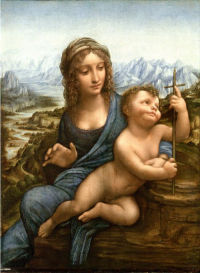Light and Vision Click on the thumbnails to explore the trail
Read more about this trail (expand)
According to Leonardo, the most important of the five senses was sight, the eye being the “window of the soul”. Leonardo thought a great deal about how the eye functioned and how we experience the world in terms of light and shade. His studies of the effects of light on form provided the basis for a revolution in the way that light, colour and space were described in painting.

- Enlarge
- Zoom & explore
- © Private collection
Madonna of the Yarnwinder (The Lansdowne Madonna) 1501-07
What causes distant objects to appear blue and hazy? In the interest of science and art, Leonardo needed to answer this question.
Recognizing that the atmosphere surrounding the earth contained moisture and dust as well as air, Leonardo deduced that the further away an object was, the more the moisture and dust would reflect light from it, blurring its true colors and details. By observing smoke and steam against a dark background, he realised why the sky was blue. He concluded that the blue color of distant mountains resulted from warm water vapor in the air illuminated by sunlight in front of the dark background of the mountains.
It was not difficult to ascertain from this that the more distant mountains were, the bluer they would appear because of the quantity of atmosphere between them and the viewer.
In this early painting, Leonardo appears to act on his advice to artists that if they should want a mountain to appear distant they should paint it blue. And if they want it to appear five times more distant, then they should make it five times bluer.
In Leonardo's words
There is another perspective which we call aerial, because through variations in the air we are made aware of the different distances of various buildings whose bases appear to rise from a single line, as might be seen with many buildings beyond a wall…
This is one of two versions of the same subject associated with Leonardo. The artist was documented as working on a small picture of this subject in 1501, after his return to Milan from Florence, for the French Secretary of State, Florimond Robertet. It is not clear which of the two paintings went to Robertet, but he appears to have received his picture in Blois in 1507.
The theme of the painting, which is likely to have been made for private devotional purposes, focuses on the mother’s love for her child, showing her gazing down at her son, and on the future passion of Christ. Jesus is completely preoccupied with a yarn-winder which, by virtue of its similarity to a crucifix, is regarded as a symbol of his death.
Mary with her right hand raised in protection, seems to want to draw the child back from the yarn-winder. But the child turns away from his mother’s loving gaze, as his entire attention is focused on the symbol of his future passion.
- Medium Oil on wood panel (transferred to canvas and later re-laid on panel)
- Size 50.2 x 36.4 cm
- Location Private collection











